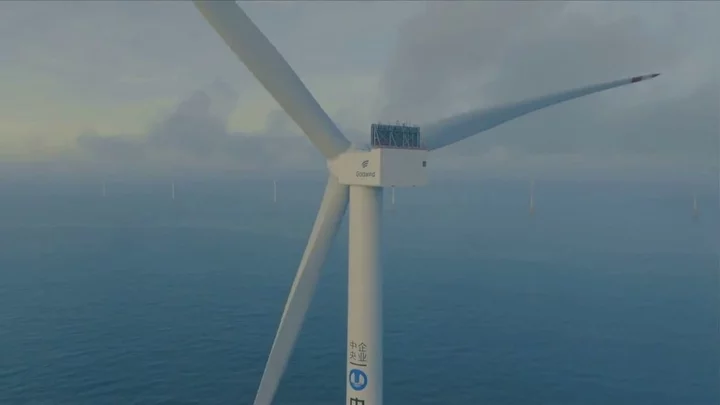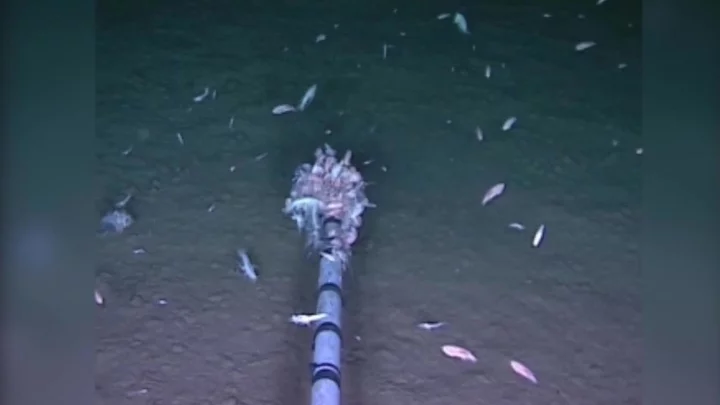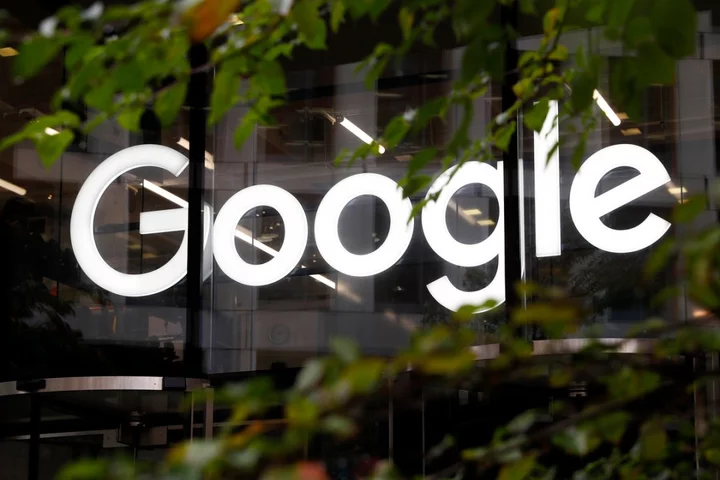
Amazon expands its virtual health clinic nationwide
Amazon's virtual clinic is now available in all 50 states and Washington, D.C., the company announced on Tuesday.
2023-08-02 01:53

Meta begins process to end news access in Canada
(Reuters) -Meta Platforms said on Tuesday it has begun the process to end access to news on Facebook and Instagram
2023-08-02 00:46

Mega wind turbine with blades twice the size of a football pitch switched on for first time
In the week that it was announced that Rishi Sunak will be granting new oil and gas licences in the North Sea, new commitments to renewable energy are being made elsewhere in the world. The China Three Gorges Corporation just turned on a mega wind turbine with blades twice the size of a football pitch in the Taiwan Strait. The state-owned energy firm has activated the biggest wind turbine on the planet offshore in a move which could produce up to 16 megawatts of energy, and it’s now been connected and hooked up to the energy grid. The MySE 16-260 turbine stands at an incredible 500ft (152m) tall and it could power thousands of homes every year. Sign up to our free Indy100 weekly newsletter In fact, it’s thought that around 36,000 homes will be served by electricity from the turbine. It’s not surprising given that each blade weighs around 54 tons and covers nearly 540,000 square feet when they rotate. Mingyang Smart Energy is the company that designed the turbine, and they released a message on LinkedIn making clear just how much wind the structure could deal with – stating that it can withstand “extreme wind speeds of 79.8 [meters per second]”. It’s a staggering feat of engineering and it’s thought that the turbine could save around 54,000 tons of carbon dioxide compared to coal power plants. More structures like one are being planned, too. Executive Director Lei Lei Zengjuan told the media: “In the next step, the 16 [megawatt] unit will be applied in batches in the second phase of the Zhangpu Liuao Offshore Wind Farm Project constructed by China Three Gorges Corporation.” It comes a few weeks after work was stopped on one of the UK’s largest offshore wind farms after its developer said that the cost of the project had soared by so much that it no longer made financial sense to push forward. Swedish energy giant Vattenfall, one of Europe’s biggest wind producers, shut down work on the development of the Norfolk Boreas site. Have your say in our news democracy. Click the upvote icon at the top of the page to help raise this article through the indy100 rankings.
2023-08-02 00:19

Worldcoin crypto launched by ChatGPT creator sees price surge
A controversial cryptocurrency started by the founder of ChatGPT has surged in price in the days following its launch, with market commentators referring to it as both “outlandish” and “revolutionary”. Worldcoin, launched last week by OpenAI boss Sam Altman, offers people a free share of the crypto token WLD in exchange for their biometric data. More than 2 million people have signed up through an iris-scanning orb, which is currently operating in 35 cities across 20 countries. The biometric data collected by Worldcoin is used to verify an individual’s “unique personhood” to ensure noone signs up more than once. It also offers a way to differentiate humans from AI bots, which Worldcoin claims is a core offering of its technology. Regulatory and legal challenges mean people are unable to sign up in certain markets, however Mr Altman claimed shortly after its launch that one person every eight seconds was signing up for the crypto project. A spokesperson for Worldcoin told The Independent that 1,500 orbs were being distributed around the world to meet demand, including to London, New York and Paris. Crypto market commentators have said that a 50 per cent price surge in the day following its launch showed the level of interest and demand in the WLD token despite concerns surrounding its rollout. “OpenAI co-founder Sam Altman’s Worldcoin project might just be one of the most ambitious cryptocurrency projects in recent years,” Louis Schoeman, a managing director at Forex Suggest, told The Independent. “The main aim of this global digital identification is to connect your World ID to websites and apps rather than traditional logins, proving you’re a real person without having to share personal data like names and emails. This sort of digital ID will be necessary in the development of AI, in order to tell the difference between humans and AI bots online. “A global digital ID enabling private identity verifications is undeniably revolutionary, however, it’s certain to stir up controversy, with many already calling the exchange of biometric data for crypto tokens an outlandish bribe.” The Worldcoin cryptocurrency spiked from $1.90 to $3.15 on the day of its launch, before dropping back below $2. It has since surged again and was trading above $2.30 on Tuesday, bucking broader market trends. Read More ChatGPT creator launches bitcoin rival that scans people’s eyeballs Meta is secretly building an AI chatbot with the personality of Abraham Lincoln Google Assistant to be ‘supercharged’ with AI like ChatGPT and Bard ChatGPT will now know who you are and what you want
2023-08-02 00:18

Meta is secretly building an AI chatbot with the personality of Abraham Lincoln
Facebook owner Meta is working on a ChatGPT-style chatbot with the personality of Abraham Lincoln, according to reports. The new AI bot is part of a series of prototypes under development at the tech giant, the Financial Times reported on Tuesday, with each one featuring a different human-like persona. The new chatbots form part of the company’s attempts to boost its engagement with its social media platforms, according to the report, citing people with knowledge of the plans. Beyond the chatbot based on the former US president, the California-based social media giant is also exploring a chatbot that advises on travel options in the style of a surfer. The purpose of these chatbots, which Meta employees have dubbed ‘personas’, will be to provide a new search function as well as offer recommendations. The report comes as Meta executives are focusing on boosting retention on its new text-based app Threads, after the app lost more than half of its users in the weeks following its launch on 5 July. The Facebook parent reported a strong rise in advertising revenue in its earnings last week, forecasting third-quarter revenue above market expectations. The company has been climbing back from a bruising 2022, buoyed by hype around emerging AI technology and an austerity drive in which it has shed around 21,000 employees since last fall. Meta launched a new version of its open-source artificial intelligence model in July called Llama 2 for commercial use, which will be distributed by Microsoft through its Azure cloud service and will run on the Windows operating system. Bloomberg News reported in July that Apple is working on AI offerings similar to OpenAI’s ChatGPT and Google’s Bard, adding that it has built its own framework, known as ‘Ajax’, to create large language models and is also testing a chatbot that some engineers call ‘Apple GPT’. Reports of a ‘Chat with an AI’ feature first emerged in June, when app researcher Alessandro Paluzzi shared screenshots of a new tool that offers users the option to ask questions and seek advice from up to 30 different AI chatbots on Instagram. Meta reportedly plans to launch the new AI chatbots in September. The Independent has reached out to Instagram for comment, though the company typically does not speak about unreleased products. Additional reporting from agencies Read More ‘I’ve got Elon Musk dying’: Voice clone baffles tech billionaire
2023-08-01 21:28

Teenager hospitalised after USB cable gets stuck inside his penis
A teenage boy was sent to a hospital with an unusual problem - a USB cable was stuck inside his penis. The incident, which was first documented in a urology case report in Science Direct in November 2021, apparently saw the 15-year-old arrive at the hospital as he had apparently been trying to use the cable to measure the inside of his penis. However, the cable had become tangled and knotted while it was inside of him causing him to lose blood through his urine. In the report, the doctors wrote: "The two distal ports of the USB wire were found to be protruding from the external urethral meatus whilst the middle part of the knotted wire remained within the urethra. The patient was an otherwise fit and healthy adolescent with no history of mental health disorders." Sign up to our new free Indy100 weekly newsletter The teenager who is from the UK had been taken to the medical facility by his mother and confessed to the medical experts when she was out of the room that he had used a cable instead of a ruler as a means of 'sexual experimentation'. An attempt to fish the cable out using a metal rod proved unsuccessful to the amount of knotting that had occurred, forcing the team to do surgery on the boy in order to retrieve the cable. They did this by cutting open the section between the genitalia and the anus so they could access the area where the cable was stuck. In the report, the doctors explain the procedure as follows: "A longitudinal peno-scrotal incision over the palpable foreign body was made and careful dissection was undertaken through deeper tissues, splitting the bulbospongiosus muscle. Both ends of the wire were pulled out successfully through the external urethral meatus." They add: "Both ends of the wire were pulled out successfully through the external urethral meatus." Thankfully the young man recovered well from the surgery and was discharged shortly afterwards. In their notes, the urology doctors admit that although cases like this are not out of the ordinary, particular cases like this are considered to be unusual. They state: "Sexual experimentation and gratification, as well as underlying mental disorders, are considered the main causes of retained foreign bodies in the urethra and bladder. Management varies depending on the shape and size of the object, and the mechanism of insertion." Have your say in our news democracy. Click the upvote icon at the top of the page to help raise this article through the indy100 rankings.
2023-08-01 20:48

Uber's post-pandemic growth is slowing
Uber has reported that its revenue ticked up 14% last quarter, marking a slower pace of growth than recent quarters when sales surged as riders returned to pre-pandemic habits.
2023-08-01 20:22

Jaw-dropping video takes viewers down to the deepest place on Earth
A mind-boggling video has shown people just how far down the deepest place on Earth is, and it is utterly terrifying. The jaw-dropping video came from a trailer for a film that features Titanic director James Cameron, who seems to have a thing about the deep ocean. In the documentary, Long Way Down: Mariana Trench for National Geographic, Cameron took part in what was called the Deepsea Challenge which saw him dive to the bottom of the Mariana Trench in the western Pacific Ocean. The Mariana Trench is some 7 miles down and is deeper than Mount Everest would be if it were pointing down into the Earth. The bottom of the trench is called the Challenger Deep and is the deepest point known on our planet. For the attempt, a submersible was built to withstand the pressure in the deepest part of the ocean and trailers for the documentary terrifyingly showed just how far down the trench is. The video revealed it took Cameron around 90 minutes to reach the bottom of the 7-mile deep trench. In a condensed 1-minute video summarising the descent, the clip continued to give facts about the ocean in a graphic. Sign up to our free Indy100 weekly newsletter Long Way Down: Mariana Trench | National Geographic www.youtube.com 90 per cent of all ocean life lives between the depths of 0 and 660ft. A depth of 800ft is the dive depth of a nuclear submarine. Continuing on from that, 1,044ft down is the deepest ever recorded scuba dive, while at 3,300ft the last trickle of sunlight begins to fade. As has been in the headlines recently following the implosion of the OceanGate submersible, the Titanic sits at a depth of 12,467ft – just over one-third of the depth of the Mariana Trench. At 36,070ft, the bottom of the Mariana Trench has been visited by only a handful of people, one of whom is Hamish Harding, the British billionaire who died onboard the Titan submersible in June 2023. Have your say in our news democracy. Click the upvote icon at the top of the page to help raise this article through the indy100 rankings.
2023-08-01 20:22

Twitter sues hate-speech watchdog, following through on its litigation threat
Twitter has sued the Center for Countering Digital Hate (CCDH), a nonprofit group that has criticized the company's handling of hate speech, following through on a litigation threat that had been publicly revealed just hours before.
2023-08-01 19:45

Giant alien-like virus structures with arms and tails found in the US
If there’s one thing the Covid pandemic taught us, it’s that viruses shouldn’t be underestimated. People are, therefore, taking note after scientists discovered a whole new range of giant virus-like particles (VLP) that have taken on “previously unimaginable shapes and forms.” The microscopic agents, resembling everything from stars to monsters, were found in just a few handfuls of forest soil. The sample was collected from Harvard Forest, near Boston in the US back in 2019, and flown over to Germany’s Max Planck Institute. Sign up for our free Indy100 weekly newsletter There, its contents were carefully examined and, at the end of last month, the findings were finally released. The team of researchers behind the investigation said that their discoveries “question our current understanding of the virosphere” and “imply that giant viruses employ a much wider array of [...] structures and mechanisms to interact with their host cells than is currently known.” In other words, the results prove how little we actually know about the universe of viruses that exist here on Earth. They also noted that the origins and functions of the different viral structures they found remain unknown – so there’s still plenty of mystery left to solve. The team at the Max Planck Institute, led by Dr Matthias Fischer, were amazed to find “an astounding diversity of virus-like particles (VLP)," in such a small sample. "Amazingly, we found that a few hundred grams of forest soil contained a greater diversity [of the structures] than that of all hitherto isolated giant viruses combined," they wrote. These included one type that resembled a supernova: Another that the teamed named the “haircut”: Another called the “turtle” morphotype: Another christened the “Christmas star”: And another called the “Gorgon” – named after the sisters with snakes for hair from Greek mythology: To clarify, VLP are molecules that closely resemble viruses, but they differ from them in one crucial way: they are non-infectious. This is because they contain no viral genetic material. Still, as virus-host systems, they are key to better understanding their potentially noxious counterparts. “[Our] findings imply that giant viruses employ a much wider array of [...] structures and mechanisms to interact with their host cells than is currently known,” the authors wrote. They ended their paper: “This fascinating window into the complex world of soil viruses leaves little doubt that the high genetic diversity of giant viruses is matched by diverse and previously unimaginable particle structures, whose origins and functions remain to be studied.” Clearly, there’s still plenty of work to be done. Have your say in our news democracy. Click the upvote icon at the top of the page to help raise this article through the indy100 rankings.
2023-08-01 15:57

Musk’s X Sues Non Profit That Tracks Hate Speech Over Report
Elon Musk’s X Corp. sued a nonprofit group that monitors online hate speech, accusing it of falsely describing
2023-08-01 13:59

Google Assistant to be ‘supercharged’ with AI like ChatGPT and Bard
Google is reportedly planning to “supercharge” its virtual personal assistant software with the inclusion of new generative artificial intelligence features similar to those in chatbots like Bard and OpenAI’s ChatGPT. Work on the new version of Google Assistant has begun with the mobile version of the product, Axios first reported, citing an internal e-mail sent to employees. The tech giant is reportedly reorganising its team working on Assistant with an anticipated elimination of “a small number of roles”. However, it remains unclear how many employees in the team will likely be affected by layoffs. “We remain deeply committed to Assistant and we are optimistic about its bright future ahead,” Axios quoted Peeyush Ranjan, the vice president of Google Assistant, and Duke Dukellis, the company’s product director, as saying. Google spokesperson Jennifer Rodstrom told The Verge in a statement that the company is currently exploring ways to use large language models like ChatGPT to “supercharge Assistant and make it even better”. The move comes as Google announced a major update to its own ChatGPT rival Bard last month, which allows the AI chatbot to respond to queries by talking. Bard draws on vast quantities of training data to come up with human-like responses to a wide range of queries. Similar to ChatGPT, Bard has proven capable of producing a range of output, from summarising texts to generating computer code, for creating games or software programmes. The decision to “supercharge” Assistant also comes as the tech giant noted in a report last month that artificial intelligence marks the “most profound” technology shift in our lifetimes with the potential to “turbocharge” the UK economy. Google estimated in the report that the economic boost from AI would be equivalent to an annual growth of 2.6 per cent, creating £200bn in extra revenues for public services and “turning around the recent growth stagnation”. The tech giant’s estimation did not account for the impact of AI on some jobs, however, with many critics expressing fear of the impact that disruptive technology has. For instance, professor Geoffrey Hinton – widely regarded as the “godfather of AI” for his research contributions to the field – resigned from his job at Google, expressing fear that “bad actors” could use new AI technologies to harm others. “It is hard to see how you can prevent the bad actors from using it for bad things... I console myself with the normal excuse: If I hadn’t done it, somebody else would have,” he said. Read More Tired of proving you’re not a robot? Say goodbye to Captcha boxes ChatGPT rival with ‘no ethical boundaries’ sold on dark web Google’s AI chatbot Bard can now talk Geothermal breakthrough uses oil drilling tech to tap renewable energy How to take the perfect picture of tonight's supermoon Twitter takes down giant ‘X’ sign on roof after a week following city investigation
2023-08-01 13:23
